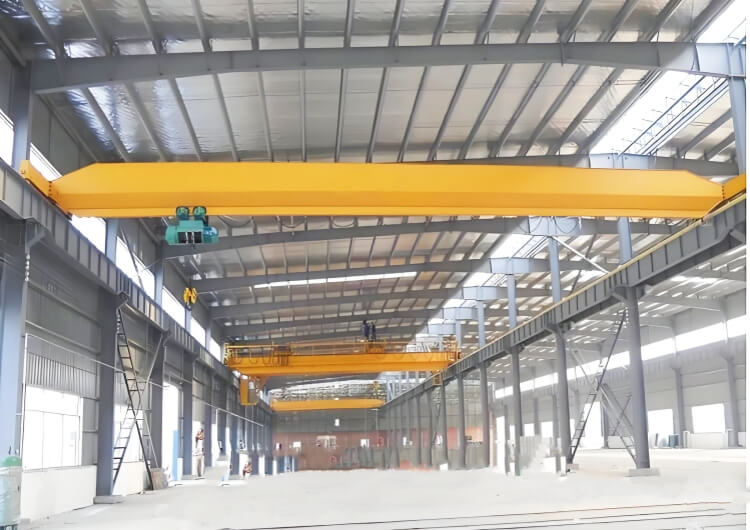Road & Bridge Gantry Cranes: Complete Lifting Solutions for Highway, Railway and Metro Projects
1. Pain Points in Road and Bridge Construction Lifting
Modern road and bridge projects are under pressure to shorten construction periods, control costs and ensure safety on increasingly complex job sites.
However, when handling heavy precast girders, tunnel segments and construction materials, contractors often face the same pain points:
-
Heavy, large-size components
Precast concrete girders and bridge segments easily weigh tens or even hundreds of tons, with long lengths and high lifting centers, making them difficult and risky to handle with conventional equipment. -
Frequent relocation of sites
Road and bridge projects move along the alignment. Equipment must be easy to dismantle, transport and reassemble, otherwise relocation time and cost become unacceptable. -
Limited and irregular working space
Urban viaducts, expressways and metro shafts often have narrow, congested work areas with strict traffic and environmental restrictions. -
High safety requirements
Lifting operations are carried out above roads, railways or active city areas. Any accident can cause serious personal injury, damage to structures and project delays. -
Tight schedules and high cost of delays
Launching girders, installing segments and removing muck must be done fast and reliably. Any downtime of lifting equipment can directly affect the critical path of the whole project.
To solve these challenges, a family of special road and bridge gantry cranes has been developed, including girder lifting gantry cranes, launching gantries, slag-out gantry cranes and rubber tyre gantry cranes.
2. Product Introduction: Specialized Gantry Cranes for Road & Bridge Projects
2.1 Girder Lifting Gantry Crane (Engineering Gantry Crane)
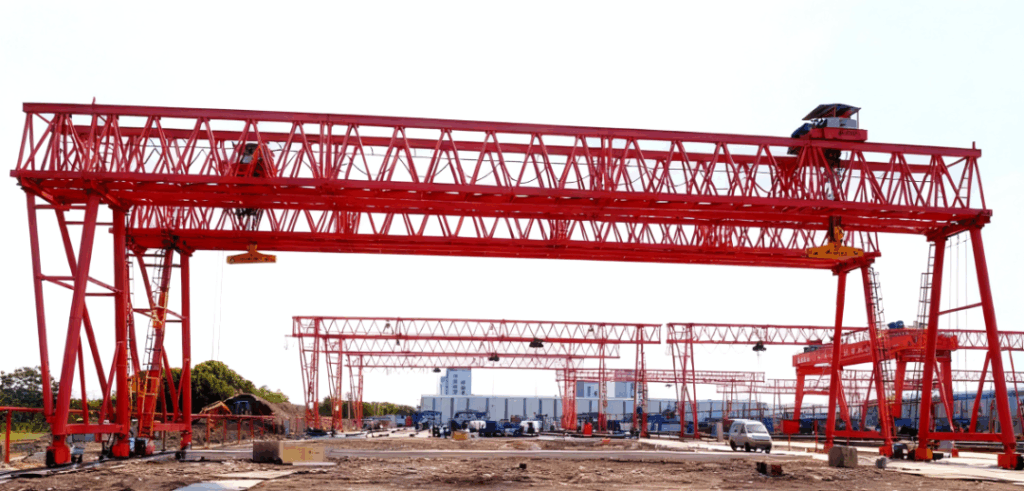
The girder lifting gantry crane is specially designed for precast beam yards and bridge projects.
It is a type of engineering gantry crane that lifts precast girders from casting beds, storage yards or transporting vehicles.
Main structural features:
-
Lattice or box-type assembled main girders, portal legs and end carriages
-
Components are connected by pins and high-strength bolts, which makes the crane easy to dismantle, transport and reassemble between projects
-
Compared with a standard gantry crane, it offers faster installation, higher mobility and better economics, especially for contractors who frequently change sites
This girder lifting gantry crane is ideal for mobile road and bridge construction companies that need to move equipment from project to project.
2.1 Girder Lifting Gantry Crane (Engineering Gantry Crane)

The launching gantry is the key equipment for placing precast girders onto the already built piers.
-
It travels along the highway or railway deck and lifts, moves and sets the girder onto the designed span.
-
It can be used for highway bridges, conventional railway bridges and high-speed railway bridges, especially for small to medium span bridges that require repetitive erection.
Because of its high erection efficiency, the launching gantry has become the core equipment considered in many national bridge design standards.
The machine body is very large and exceeds standard railway or highway transport limits, so it is usually disassembled into modules for transport and then assembled again at site according to design principles.
2.1 Girder Lifting Gantry Crane (Engineering Gantry Crane)
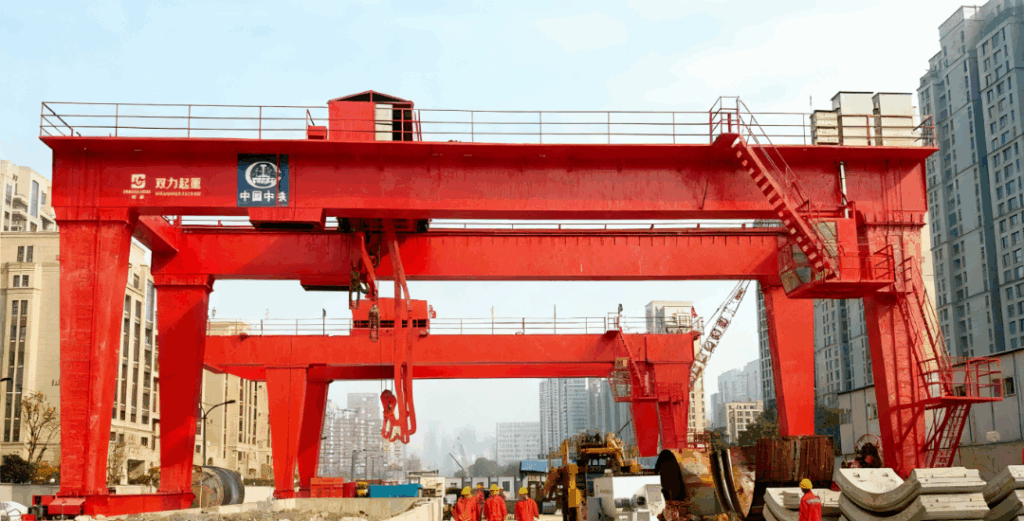
The slag-out gantry crane is used mainly in metro, subway and tunnel projects to remove muck and construction waste from shafts or working pits.
-
It usually works together with skip buckets, hoppers or containers, lifting muck from below ground to ground level.
-
The crane can also handle segments, rebar cages and other tunnel materials, improving the overall logistics of underground works.
With precise control and continuous working ability, the slag-out gantry crane helps contractors keep the shaft clean, shorten cycle times and improve safety around the shaft opening.
2.4 Rubber Tyre Gantry Crane for Bridge Deck Operations
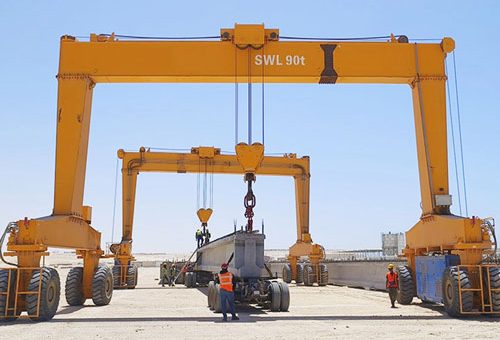
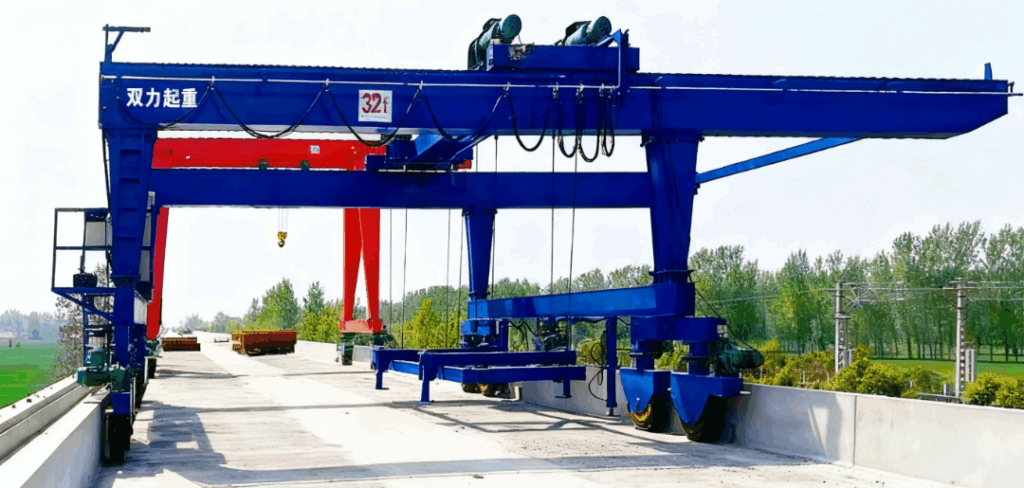
The rubber tyre gantry crane (RTG) for road and bridge construction is a mobile gantry crane running on rubber tyres instead of rails.
-
Single-girder rubber tyre gantry crane
Suitable for lifting formwork, rebar cages, light girders or precast slabs.
With a compact structure, it can run directly on the bridge deck or road base, turning flexibly. -
Double-girder rubber tyre gantry crane
Designed for heavier loads such as large precast girders or long concrete members.
It provides higher lifting capacity, better stability and often comes with side-shifting or steering functions to adapt to complex alignment.
Rubber tyre gantry cranes are particularly suitable for projects without permanent rails, where lifting equipment must follow the progress of the bridge deck construction.
3. Application Scenarios of Road & Bridge Gantry Cranes
These specialized gantry cranes cover almost the entire lifting cycle of road and bridge projects:
3.1 Precast Girder Production and Storage Yards
-
Girder lifting gantry cranes handle lifting, turning and stacking of precast beams.
-
They move girders from casting beds to curing areas, then to storage zones or transport trailers.
-
Their modular structure makes it easy to relocate when the precast yard is moved or expanded.
3.2 Highway and Railway Bridge Erection
-
Launching gantries travel along the bridge alignment, placing precast girders span by span.
-
Together with our solutions for gantry cranes in bridge construction, they reduce the need for large ground-based cranes and simplify temporary works on site.
-
When combined with girder lifting gantries in the yard, they form a complete precast + erection solution.
3.3 Metro, Subway and Tunnel Construction
-
Slag-out gantry cranes are installed at shafts or portals to lift muck, segments and materials.
-
They support shield tunnelling, NATM and cut-and-cover methods, ensuring efficient vertical transportation.
-
In urban environments, they help keep the site compact, organized and safe.
3.4 Bridge Deck, Approach and Municipal Projects
-
Rubber tyre gantry cranes work directly on bridge decks, approach roads and municipal projects.
-
They can lift formwork, precast slabs, parapets and utilities, moving flexibly along the deck.
-
Their tyre-type travelling system avoids building permanent rails and adapts to changing alignment and gradients.
Construction site pictures


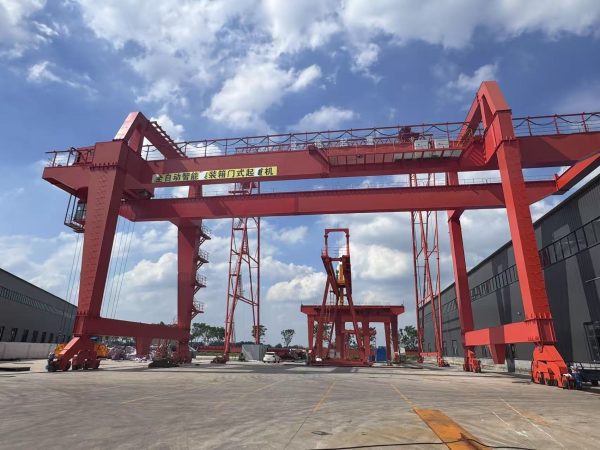
4. Typical Technical Parameters for Road & Bridge Gantry Cranes
Below are typical parameter ranges for different types of road and bridge gantry cranes.
Final specifications will be customized according to your project.
| Type | Capacity (t) | Span (m) | Lifting Height (m) | Main Features |
|---|---|---|---|---|
| Girder Lifting Gantry Crane | 30 – 160 | 20 – 40 | 10 – 20 | Assembled structure, pin & bolt connection, easy relocation |
| Launching Gantry (Erection) | 80 – 600 | 20 – 50 (span) | Up to project need | Travels on bridge deck, for highway & railway beam erection |
| Slag-Out Gantry Crane | 10 – 80 | 10 – 30 | 20 – 40 | For metro shafts, muck handling & segment lifting |
| Single-Girder Rubber Tyre Gantry | 10 – 40 | 10 – 30 | 6 – 12 | Tyre-type travelling, flexible turning, suitable for deck work |
| Double-Girder Rubber Tyre Gantry | 32 – 120 | 15 – 35 | 6 – 12 | High capacity, stable travelling, optional side shifting & steering |
Provide your girder size, weight, span, construction method and site layout, and we will calculate a detailed technical proposal and layout drawing for your project.
5. Project Case: Integrated Road & Bridge Gantry Crane Solution
Project: Urban expressway & metro combined construction
Location: Asia
Scope: Precast beam yard, highway bridge erection and metro station shaft construction
5.1 Equipment Configuration
-
Two 100 t + 100 t Girder Lifting Gantry Cranes
-
Used in the precast yard for lifting, turning and loading highway girders.
-
Assembled lattice structure with high-strength bolt connections for fast relocation.
-
-
One 300 t Launching Gantry for Highway Bridge
-
Erected on the completed piers, travelling along the bridge deck to place girders span by span.
-
Equipped with variable frequency hoisting and trolley travel to ensure smooth, precise placement.
-
-
One 50 t Slag-Out Gantry Crane at Metro Shaft
-
Installed at a deep shaft connecting to the future metro station.
-
Used to lift muck, segments and materials, supporting shield tunnelling.
-
-
One 40 t Double-Girder Rubber Tyre Gantry Crane
-
Running on the newly poured bridge deck for formwork handling and utility installation.
-
Tyre steering system allows straight running and crab movement.
-
5.2 Results and Benefits
-
Precast + erection cycle shortened, allowing multiple spans to be erected each week.
-
Shaft muck handling capacity increased significantly, keeping tunnelling TBM utilization high.
-
Site layout became more compact with fewer ground-based cranes, reducing traffic disruption.
-
The modular girder lifting gantries and rubber tyre gantry can be relocated to the next project with limited dismantling time, protecting the contractor’s long-term investment.
This case shows how a complete road and bridge gantry crane package can support highway, railway and metro construction within one integrated solution.
6. Solution Analysis: Why Specialized Gantry Cranes Work Better
From both engineering and project management perspectives, specialized road and bridge gantry cranes bring clear advantages over general-purpose lifting equipment:
-
Purpose-built structure for bridge loads
Girder lifting gantries and launching gantries are designed according to bridge girder geometry, lifting points and load combinations, ensuring stability and safety during erection. -
Modular and transport-friendly design
Assembled main girders, portal legs and end carriages are connected with pins and high-strength bolts.
This allows components to be transported within transport limits and quickly reassembled on site. -
High efficiency and continuous operation
Launching gantries and slag-out gantries are tailored for repetitive cycles: lifting, travelling and placing.
Combined with VFD control and optimized working sequences, they significantly increase erection speed and muck removal capacity. -
Adaptable to complex site conditions
Rubber tyre gantry cranes can follow the bridge alignment, handle curves and gradients, and work where rails are not feasible.
Slag-out gantries can be designed for different shaft diameters and depths. -
Improved safety and reduced risk
With dedicated structures, anti-wind devices, overload protection, limit switches and hydraulic safety systems, these cranes reduce the risk of overturning, derailment or uncontrolled movement. -
Better life-cycle economics
Though the initial investment may be higher than renting general cranes, the reusable modular design and high efficiency help lower cost per ton lifted over multiple projects.
7. Selection Suggestions: How to Choose the Right Road & Bridge Gantry Crane
To choose a suitable road and bridge gantry crane solution, we recommend the following steps:
7.1 Confirm Project Type and Construction Method
-
Highway, urban expressway or municipal bridge
-
Conventional railway or high-speed railway
-
Metro, subway or tunnel project
-
Precast erection, in-situ casting, or combined method
Different project types will require different combinations of girder lifting gantry crane, launching gantry, slag-out gantry crane and rubber tyre gantry crane.
7.2 Define Key Technical Parameters
-
Maximum girder weight, length, width and number of lifting points
-
Design span and bridge alignment (straight, curve, gradient)
-
Required erection capacity (spans per month)
-
Shaft depth and muck output for metro projects
7.3 Evaluate Site Conditions and Relocation Requirements
-
Available assembly space for launching gantries and girder lifting gantries
-
Transport routes, lifting restrictions and environmental limitations
-
Whether the equipment needs to be moved to other projects frequently
7.4 Choose Control, Safety and Automation Level
-
Hoisting and travelling speed control (single speed, dual speed, VFD)
-
Required automation functions (synchronous lifting, overload monitoring, data recording)
-
Safety requirements: anti-wind, anti-tilt, emergency descent, wind-proof anchors, etc.
7.5 Select a Professional Supplier
-
Proven references in road, railway and metro projects
-
Ability to provide full package engineering, including design, manufacturing, on-site assembly and commissioning
-
Professional training and after-sales service, with spare parts supply and remote technical support
Share your bridge drawings, girder list and construction schedule, and our engineering team will provide a customized road and bridge gantry crane proposal and budget for your project.

Expert in Overhead Crane/Gantry Crane/Jib Crane/Crane Parts Solutions
Eileen
With 20+ years of experience in the Crane Overseas Export Industry, helped 10,000+ customers with their pre-sales questions and concerns, if you have any related needs, please feel free to contact me!
FREQUENTLY ASKED QUESTIONS
———Road & Bridge Gantry Cranes
What is the difference between a girder lifting gantry crane and a standard gantry crane?
A girder lifting gantry crane is specially designed for precast beam handling. It uses assembled lattice or box-type structures with pin and bolt connections for easy dismantling and transport. A standard gantry crane is usually welded, less convenient to relocate and not optimized for bridge girder lifting.
Can one launching gantry be reused on different projects?
Yes. Most launching gantries are modular systems. After finishing one project, they can be dismantled, transported and reassembled on the next project, as long as spans, girder weight and alignment are within the design range.
How are these large gantry cranes transported to the site?
The main girders, legs and end carriages are divided into transportable sections that meet highway or railway transport limits. They are shipped to site by trucks or rail, then assembled with cranes and hydraulic jacks according to a detailed assembly procedure.
What information do you need to design a slag-out gantry crane for a metro shaft?
Normally we need shaft diameter and depth, muck output per day, lifting height, required working speed, available space around the shaft, and local power supply data. With this, we can design the appropriate capacity, span and hoisting mechanism.
How long is the typical delivery time for road and bridge gantry cranes?
Delivery time depends on capacity and complexity. For standard girder lifting gantries or rubber tyre gantry cranes, it is usually several months from order to shipment. Large launching gantries and complex slag-out systems may require a longer engineering period. We will provide a detailed schedule together with our quotation.
Contact Us Now
Have questions about our cranes or need help?
Reach out to our friendly team for expert support and guidance.
We are here to help you power your journey towards a greener future !
Address: Crane Industry Park, Xinxiang City Henan Provice

